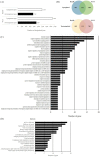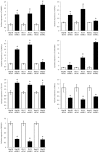Transcriptomic analysis reveals the oncogenic role of S6K1 in hepatocellular carcinoma
- PMID: 32201535
- PMCID: PMC7065997
- DOI: 10.7150/jca.40726
Transcriptomic analysis reveals the oncogenic role of S6K1 in hepatocellular carcinoma
Abstract
The p70 ribosomal protein S6 kinase 1 (S6K1), a serine/threonine kinase, is commonly overexpressed in a variety of cancers. However, its expression level and functional roles in hepatocellular carcinoma (HCC), which ranks as the third leading cause of cancer-related death worldwide, is still largely unknown. In the current report, we show the in vivo and in vitro overexpression of S6K1 in HCC. In the functional analysis, we demonstrate that S6K1 is required for the proliferation and colony formation abilities in HCC. By using comparative transcriptomic analysis followed by gene ontology enrichment analysis and Ingenuity Pathway Analysis, we find that the depletion of S6K1 can elevate the expression of a cluster of apoptotic genes, tumor suppressor genes and immune responsive genes. Moreover, the knockdown of S6K1 is predicted to reduce the tumorigenicity of HCC through the regulation of hubs of genes including STAT1, HDAC4, CEBPA and ONECUT1. In conclusion, we demonstrate the oncogenic role of S6K1 in HCC, suggesting the possible use of S6K1 as a therapeutic target for HCC treatment.
Keywords: S6K1; hepatocellular carcinoma; proliferation; transcriptome; tumorigenicity.
© The author(s).
Conflict of interest statement
Competing Interests: The authors have declared that no competing interest exists.
Figures






Similar articles
-
Loss of AIM2 expression promotes hepatocarcinoma progression through activation of mTOR-S6K1 pathway.Oncotarget. 2016 Jun 14;7(24):36185-36197. doi: 10.18632/oncotarget.9154. Oncotarget. 2016. PMID: 27167192 Free PMC article.
-
Bifunctional enzyme ATIC promotes propagation of hepatocellular carcinoma by regulating AMPK-mTOR-S6 K1 signaling.Cell Commun Signal. 2017 Dec 16;15(1):52. doi: 10.1186/s12964-017-0208-8. Cell Commun Signal. 2017. PMID: 29246230 Free PMC article.
-
Golgi phosphoprotein 3 (GOLPH3) promotes hepatocellular carcinoma progression by activating mTOR signaling pathway.BMC Cancer. 2018 Jun 18;18(1):661. doi: 10.1186/s12885-018-4458-7. BMC Cancer. 2018. PMID: 29914442 Free PMC article.
-
Pleiotropic effects of methionine adenosyltransferases deregulation as determinants of liver cancer progression and prognosis.J Hepatol. 2013 Oct;59(4):830-41. doi: 10.1016/j.jhep.2013.04.031. Epub 2013 May 7. J Hepatol. 2013. PMID: 23665184 Review.
-
The Prognostic Role of Ribosomal Protein S6 Kinase 1 Pathway in Patients With Solid Tumors: A Meta-Analysis.Front Oncol. 2019 May 14;9:390. doi: 10.3389/fonc.2019.00390. eCollection 2019. Front Oncol. 2019. PMID: 31139572 Free PMC article.
Cited by
-
Comprehensive analysis of pan-cancer reveals potential of ASF1B as a prognostic and immunological biomarker.Cancer Med. 2021 Oct;10(19):6897-6916. doi: 10.1002/cam4.4203. Epub 2021 Sep 2. Cancer Med. 2021. PMID: 34472711 Free PMC article.
-
RNA-seq analysis reveals transcriptome changes in livers from Efcab4b knockout mice.Biochem Biophys Rep. 2025 Feb 15;41:101944. doi: 10.1016/j.bbrep.2025.101944. eCollection 2025 Mar. Biochem Biophys Rep. 2025. PMID: 40034259 Free PMC article.
-
Biomarker Discovery for Hepatocellular Carcinoma in Patients with Liver Cirrhosis Using Untargeted Metabolomics and Lipidomics Studies.Metabolites. 2023 Oct 2;13(10):1047. doi: 10.3390/metabo13101047. Metabolites. 2023. PMID: 37887372 Free PMC article.
-
A Prognostic Model for Brain Glioma Patients Based on 9 Signature Glycolytic Genes.Biomed Res Int. 2021 Jun 16;2021:6680066. doi: 10.1155/2021/6680066. eCollection 2021. Biomed Res Int. 2021. Retraction in: Biomed Res Int. 2024 Mar 20;2024:9854370. doi: 10.1155/2024/9854370. PMID: 34222480 Free PMC article. Retracted.
-
Comparative Transcriptomic Analysis Reveals the Immunosuppressive Targets of Mesalazine in Dextran Sulfate Sodium-Induced Ulcerative Colitis.Front Genet. 2021 Aug 11;12:698983. doi: 10.3389/fgene.2021.698983. eCollection 2021. Front Genet. 2021. PMID: 34456974 Free PMC article.
References
-
- Giannelli G, Rani B, Dituri F. et al. Moving towards personalised therapy in patients with hepatocellular carcinoma: the role of the microenvironment. Gut. 2014;63:1668–1676. - PubMed
-
- Lai KP, Chen J, He M. et al. Overexpression of ZFX confers self-renewal and chemoresistance properties in hepatocellular carcinoma. Int J Cancer. 2014;135:1790–1799. - PubMed
-
- Liu L, Dai Y, Chen J. et al. Maelstrom promotes hepatocellular carcinoma metastasis by inducing epithelial-mesenchymal transition by way of Akt/GSK-3beta/Snail signaling. Hepatology. 2014;59:531–543. - PubMed
-
- Ma S, Lee TK, Zheng BJ. et al. CD133+ HCC cancer stem cells confer chemoresistance by preferential expression of the Akt/PKB survival pathway. Oncogene. 2008;27:1749–1758. - PubMed
LinkOut - more resources
Full Text Sources
Research Materials
Miscellaneous

